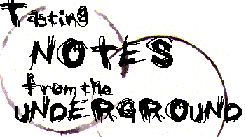|
|
|
J. Lewis Cooper Co.’s whiz bang sales rep
Matt Frederick dropped by recently
with five generous samples from the portfolio of
Palm Bay Imports,
the Boca Raton, Florida wine importer of note. These weren’t just any
old bottles of cheap swill, but rather some serious selections from
three respected Italian producers, so needless to say, Kim and I gave
them our full attention.
Sella & Mosca is perhaps the finest wine
producing estate on the island of Sardinia, with more than 1,200 acres
under vine; their I Piani estate is the site of the second
largest contiguous vineyard in Italy. Besides growing native grapes
such as Vermentino and Cannonau, they also produce international
varietals, as with the following offering.
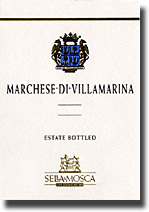 1999
Sella & Mosca Marchese di Villamarina, 100% Cabernet Sauvignon,
$47.50, 12.5% alc.: This dark garnet colored Sardinian claret offers a
generous nose of chocolate cherries and licorice that echoes and expands
on the palate with subtle undertones of earth, sticks and underbrush, so
while it is made in the “international style,” it also reveals a sense
of place. Medium full bodied, and well structured, yet smooth in
texture, it shows some extraction and just a little heat on the
reasonably long finish. All in all, interesting and quite enjoyable, if
a wee bit heavy on the chocolate, but that’s a minor complaint. From
the Marchese di Villamarine single vineyard on the Sella & Mosca
estate, originally planted in the late 1950s, and now gradually being
replanted to maintain the overall longevity of these vines. Matured 18
months in small French oak casks, then spending 12 months in large oak
barrels, followed by an additional 18 months in bottle prior to
release. Find this wine 1999
Sella & Mosca Marchese di Villamarina, 100% Cabernet Sauvignon,
$47.50, 12.5% alc.: This dark garnet colored Sardinian claret offers a
generous nose of chocolate cherries and licorice that echoes and expands
on the palate with subtle undertones of earth, sticks and underbrush, so
while it is made in the “international style,” it also reveals a sense
of place. Medium full bodied, and well structured, yet smooth in
texture, it shows some extraction and just a little heat on the
reasonably long finish. All in all, interesting and quite enjoyable, if
a wee bit heavy on the chocolate, but that’s a minor complaint. From
the Marchese di Villamarine single vineyard on the Sella & Mosca
estate, originally planted in the late 1950s, and now gradually being
replanted to maintain the overall longevity of these vines. Matured 18
months in small French oak casks, then spending 12 months in large oak
barrels, followed by an additional 18 months in bottle prior to
release. Find this wine
|
|
The late boxer and spaghetti western producer
Italo Zingarelli bought the rundown
Rocca delle Macie estate in 1973, and with his son
Sergio, turned it into a first rate
Tuscan wine producer. In 1984, they added the Fizzano estate to
their holdings, supplying them with the fruit for one of the excellent
wines noted below. Italo passed away in 2000, and now Sergio and his
wife Daniela oversee the day-to-day
management of the operation.
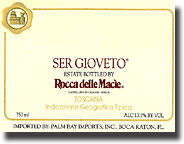 1999
Rocca delle Macie Ser Gioveto ®
Toscana, 75% Sangiovese, 15%
Merlot, 10% Cabernet Sauvignon, $38.99, 13.5% alc.: Named for Sergio
Zingarelli, this dark garnet isn’t showing a lot on the nose when first
poured, but gives nice, earthy dried sour cherries with subtle sticky
undertones in the mouth, being medium full bodied, with a nice Tuscan
personality. No flash or extracted characteristics here, just a solid,
well balanced, substantial wine that shows more earth and sticks with
air, and that’s a good thing. From the Rocca delle Macie Le Macie and
Sant’Alfonso estate vineyards, with soil composed of calcareous
limestone. Grapes are destemmed and softly pressed; fermentation is
completed on the skins at 75º - 79ºF, with malolactic fermentation
occurring in the spring. Aged 6-12 months in small 225L barriques made
of French oak, and then further maturated in the bottle for about nine
months prior to release. Find this wine 1999
Rocca delle Macie Ser Gioveto ®
Toscana, 75% Sangiovese, 15%
Merlot, 10% Cabernet Sauvignon, $38.99, 13.5% alc.: Named for Sergio
Zingarelli, this dark garnet isn’t showing a lot on the nose when first
poured, but gives nice, earthy dried sour cherries with subtle sticky
undertones in the mouth, being medium full bodied, with a nice Tuscan
personality. No flash or extracted characteristics here, just a solid,
well balanced, substantial wine that shows more earth and sticks with
air, and that’s a good thing. From the Rocca delle Macie Le Macie and
Sant’Alfonso estate vineyards, with soil composed of calcareous
limestone. Grapes are destemmed and softly pressed; fermentation is
completed on the skins at 75º - 79ºF, with malolactic fermentation
occurring in the spring. Aged 6-12 months in small 225L barriques made
of French oak, and then further maturated in the bottle for about nine
months prior to release. Find this wine
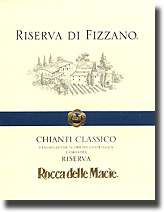 2000
Rocca delle Macie Chianti Classico Riserva di Fizzano, 85%
Sangiovese Grosso, 10% Cabernet Sauvignon, 5% Merlot, $28.99, 13.5% alc.:
Produced exclusively from Rocca delle Macie’s Fizzano vineyard, this
dark garnet grudgingly gives up some reticent licorice and black fruit
on the nose, but on the palate, it’s much more generous, with its sleek,
lovely dried cherry, blackberry and black currant flavors, accented with
earth, sticks and licorice and a nice, long finish. The good structure
promises a nice future, but this wine is sexy already; excellent Chianti
Classico Riserva, and its best days are still ahead. This wine is only
made in “exceptional years;” after the traditional fermentation, it is
matured in French oak barrels for over two years, and then spends close
to a year in bottle before release. Find this wine 2000
Rocca delle Macie Chianti Classico Riserva di Fizzano, 85%
Sangiovese Grosso, 10% Cabernet Sauvignon, 5% Merlot, $28.99, 13.5% alc.:
Produced exclusively from Rocca delle Macie’s Fizzano vineyard, this
dark garnet grudgingly gives up some reticent licorice and black fruit
on the nose, but on the palate, it’s much more generous, with its sleek,
lovely dried cherry, blackberry and black currant flavors, accented with
earth, sticks and licorice and a nice, long finish. The good structure
promises a nice future, but this wine is sexy already; excellent Chianti
Classico Riserva, and its best days are still ahead. This wine is only
made in “exceptional years;” after the traditional fermentation, it is
matured in French oak barrels for over two years, and then spends close
to a year in bottle before release. Find this wine
2000 Rocca delle Macie Roccato ®, 50%
Cabernet Sauvignon, 50% Sangiovese Grosso, $45, 13.5% alc.: Like the
other Rocca delle Macies tasted here, this dark garnet doesn’t give much
on the nose on this occasion, but it delivers plenty of earthy, sticky
black currant, dried sour cherry and dark chocolate flavors that are
dense and concentrated, but not over – extracted. It shows impressive
structure (tannins show most on the long finish), and even with extended
air, it’s obvious that this is a big wine whose best days lie well ahead
of it. While it’s approachable now, and likes food to bring out its
best, it really needs to be left alone until at least 2010, and probably
well beyond. Sourced exclusively from the Rocca delle Macie estate
vineyards in Castellina, in Chianti, and only made in the best vintages;
the wine undergoes traditional maceration of the must for 15 days at
86°F, followed by 12 months in small 225L French oak barriques, and
about one year in the bottle before release. Find this wine
With its winemaking history dating back to the
1700s, Col d’Orcia’s reputation is firmly planted in their fine
Brunello di Montalcino. However, they’ve also produced some of
the best Cabernet Sauvignon in Italy for well over a decade now; sadly,
the following example didn’t seem to live up to that quality level.
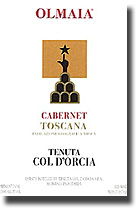 1999
Tenuta Col d’Orcia Olmaia ® Cabernet di Toscana, 100% Cabernet
Sauvignon (Bordeaux clones), $76.99, 13.7% alc.: This deep, dark garnet
colored Cabernet seems almost flat when tasted after the other four
wines on this occasion; perhaps that’s an unfair observation, but when
the price tag is considered, I don’t think so. It shows earthy black
currant with some sea air on the nose, and these follow through on the
palate with good structure, some added leather and mahogany, and with
extended air, a note of tobacco. It seems to be missing something on
the mid – palate, and isn’t up to the rest of the competition in this
group, giving the impression that it’s quite overpriced for what it
offers. Maybe it was just an off bottle, so the jury’s still out on
this one. Sourced from the south-southwest facing Bozzolino and
Giardino vineyards, planted in 1984 in Sant’Angelo in Colle, a
hilly area approximately 1,200 feet above sea level, near Montalcino in
the province of Siena; the soil is medium weight with some calcareous
pebbles. Grapes are fermented on the skins for 20 days in 150 hl
stainless steel vats at a controlled temperature of less than 30ºC, and
then aged in new French oak barriques (Allier, Tronçais and Blois) for
18 months, followed by for an additional 12 months in bottle before
release. Find this wine 1999
Tenuta Col d’Orcia Olmaia ® Cabernet di Toscana, 100% Cabernet
Sauvignon (Bordeaux clones), $76.99, 13.7% alc.: This deep, dark garnet
colored Cabernet seems almost flat when tasted after the other four
wines on this occasion; perhaps that’s an unfair observation, but when
the price tag is considered, I don’t think so. It shows earthy black
currant with some sea air on the nose, and these follow through on the
palate with good structure, some added leather and mahogany, and with
extended air, a note of tobacco. It seems to be missing something on
the mid – palate, and isn’t up to the rest of the competition in this
group, giving the impression that it’s quite overpriced for what it
offers. Maybe it was just an off bottle, so the jury’s still out on
this one. Sourced from the south-southwest facing Bozzolino and
Giardino vineyards, planted in 1984 in Sant’Angelo in Colle, a
hilly area approximately 1,200 feet above sea level, near Montalcino in
the province of Siena; the soil is medium weight with some calcareous
pebbles. Grapes are fermented on the skins for 20 days in 150 hl
stainless steel vats at a controlled temperature of less than 30ºC, and
then aged in new French oak barriques (Allier, Tronçais and Blois) for
18 months, followed by for an additional 12 months in bottle before
release. Find this wine
Reporting from Day-twah,
Bastardo

Other Recent Wine Explorations
4 By Egelhoff
More New Wines From
Wyncroft
All Pig Dinner at Five
Lakes Grill
Red Wings and Red
Rhones 2006
Cassoulet Fest with
Wines From the Languedoc
Not
Just Flotsam & Jetsam
Some New World Clarets and
a Single Sauvignon
Francophilia 2005
Back to
April '06 Index
Back to the
Underground
Index
Back to the Top


© George Heritier April 2006
|


